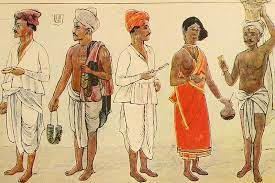Fashion is often seen as a modern phenomenon, but the Indus Valley Civilization, one of the world’s oldest urban societies, was remarkably fashion-forward in its own right. From sophisticated textiles to intricate jewelry, the people of the Indus Valley embraced style and elegance in their attire. Exploring the fashion trends of this ancient civilization provides insights into its social dynamics, cultural values, and artistic achievements.
Apparel of the Elite:
In the Indus Valley Civilization, clothing was more than just a practical necessity; it was a symbol of social status and identity. The elite members of society adorned themselves with finely crafted garments made from luxurious textiles such as cotton and silk. These garments were often dyed in rich colors using natural dyes derived from plants and minerals. Elaborate drapery and embellishments further accentuated the prestige of the wearer, reflecting their wealth and influence.
Gender Distinctions:
Like many ancient cultures, the Indus Valley Civilization had distinct clothing styles for men and women. Men typically wore draped garments such as dhotis (wrapped skirts) or loincloths, paired with shawls or cloaks for warmth. Women, on the other hand, favored draped garments like saris or draped skirts, often adorned with jewelry and decorative ornaments. These gender distinctions in clothing not only reflected societal norms but also served as expressions of identity and cultural values.
Textile Innovation:
The Indus Valley Civilization was renowned for its mastery of textile production, which enabled the creation of diverse and sophisticated garments. Cotton, in particular, was a staple fiber used in the production of textiles, with evidence of cotton cultivation and weaving found throughout the region. The civilization’s skilled artisans employed various weaving techniques to create fabrics of different textures and patterns, showcasing their creativity and technical expertise.
Jewelry and Accessories:
In addition to clothing, jewelry played a crucial role in ancient Indus Valley fashion. Excavations at sites such as Harappa and Mohenjo-Daro have unearthed a treasure trove of jewelry made from gold, silver, copper, and semi-precious stones. These intricate pieces included necklaces, bracelets, earrings, and hair ornaments, which were worn not only for adornment but also as symbols of status, wealth, and religious significance. The craftsmanship and artistic sophistication of Indus Valley jewelry continue to inspire admiration to this day.
Cultural Influences:
The fashion trends of the Indus Valley Civilization were not limited to the confines of the region; they also had a profound impact on neighboring cultures and societies. Through trade and cultural exchange, Indus Valley textiles, jewelry, and other fashion items found their way to distant lands, influencing the styles and tastes of ancient civilizations across Asia and the Middle East. This interconnectedness highlights the civilization’s role as a cultural hub and a center of innovation in the ancient world.
Conclusion:
The Indus Valley Civilization may have faded into the annals of history, but its legacy in fashion and style endures to this day. Through its innovative textiles, exquisite jewelry, and distinctive attire, the civilization set trends millennia ago that continue to resonate with contemporary fashion enthusiasts. By exploring the fashion-forward tendencies of the Indus Valley people, we gain a deeper appreciation for their creativity, craftsmanship, and enduring influence on global fashion culture.






